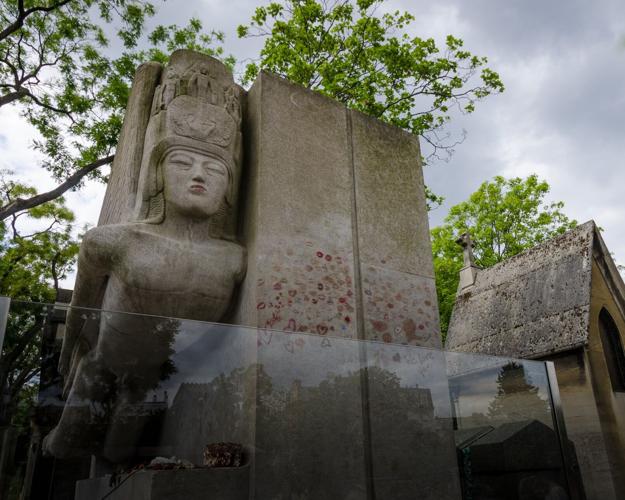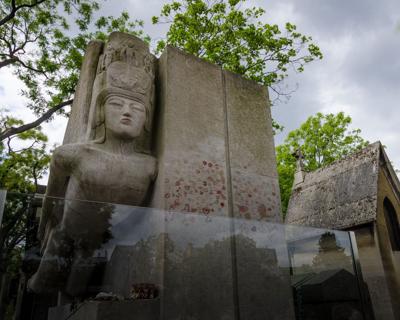It may sound macabre to visit the dead as a travel activity. Admittedly, my growing interest has taken me by surprise over the years. Sometimes I would add burial sites to my itinerary: EvitaÔÇÖs family grave in Buenos Aires, for example, and Oscar WildeÔÇÖs much-kissed memorial in Cimeti├Ęre du P├Ęre-Lachaise in Paris.
Other times, I would discover a cemetery by accident, as I did when I found Jewish graves during a hill walk in Vilnius, Lithuania. Some graves were moved there after Jewish cemeteries were destroyed by the Soviets, who used the tombstones to construct things such as staircases.
After many accidental discoveries, I now seek out graves anywhere I visit. I believe no place can tell you more about a city, town or country than the grounds of those who are gone, buried with their mythologies. This has led me to war cemeteries, pet cemeteries, other grave sites and memorial monuments around the world.

The writer found a sense of history and peace while visiting burial grounds around the world, including this one at Bolton Abbey, England.
Jennifer SizelandSome of the most well-known burial grounds tell disturbing stories of humanityÔÇÖs past. On a trip to Cambodia, I visited the memorial site on the ÔÇťkilling fieldsÔÇŁ near Phnom Penh. In rural areas like this, the murderous Khmer Rouge regime buried an estimated two million victims from 1975 to 1979.
As I stood next to the monument of skulls in a field full of remains, where victimsÔÇÖ clothes could still be seen poking above the earth, I understood the cruelty of genocide more viscerally than any book or film could convey.
While the killing fields are obvious in their intention, many cemeteries harbour quieter histories. In EdinburghÔÇÖs Greyfriars Cemetery, one of the most famous graveyards in the world, I learned that even innocuous-looking structures can reflect a darker past: Two ÔÇťmortsafesÔÇŁ (protective cages) remain from the 18th century, when the city was infamous for profiteering body-snatchers. The remains were sold to the local anatomy school, which didnÔÇÖt question their suspicious origins.
On a less grisly note, the cemetery also features a statue of Greyfriars Bobby, the dog that reputedly guarded his ownerÔÇÖs grave for 14 years. It is now believed he was a stray, encouraged to stay around to bring tourists to the church ÔÇö just as his statue does now.
In popular cities such as Edinburgh and Paris, cemeteries offer the perfect respite to weary travellers like me. Even ones that have become tourist attractions still have quieter parts, where I like to enjoy a sandwich, bird-watch and commune with resident cats. IÔÇÖve spent many hours exploring ManchesterÔÇÖs Southern Cemetery, one of the largest municipal graveyards in Europe, where the celebrated artist L.S. Lowry was laid to rest. It was here that I discovered heÔÇÖd left his entire estate to a fan-turned-friend whoÔÇÖd written to him, based on their shared last name.
Another intriguing aspect of cemeteries is the way that gravestones and monuments evolve alongside fluctuating economies and changing beliefs. In the British city of Leeds, for example, whimsical Victorian angel-topped graves gave way to shinier, more utilitarian headstones. In the Philippines, I saw the stark contrast between Indigenous tradition and the modern day in the hanging coffins of Sagada, where caskets are suspended on cliff sides next to a church cemetery. Different religions often converge in cemeteries, too, providing a window into the faiths of the people.

In the Philippines, the hanging coffins of Sagada reflect Indigenous tradition.
Jennifer SizelandCemeteries can be places of beauty; some are perched on the edge of a coastline (the Heysham rock tombs in England, for example), or have headstones covered in desert sand (the Cemetery Sahline in Tunisia). Graveyards have provided┬áartistic inspiration:┬áCharles Dickens frequented them, writing an early scene in ÔÇťGreat ExpectationsÔÇŁ based on his observations. The author himself is buried in the PoetsÔÇÖ Corner of Westminster Abbey, home to the graves and memorials of more than 100 poets and writers.
Just like Dickens, I like to contemplate quietly┬áin cemeteries, as itÔÇÖs so rare to find somewhere truly peaceful in busy towns and cities. Nothing is more humbling than the idea that the present will always become the past, which is something we can learn so much from. These are places where history, tradition, religion, architecture and culture intersect in ways we may not realize, and thereÔÇÖs always something intriguing to unearth.

































To join the conversation set a first and last name in your user profile.
Sign in or register for free to join the Conversation